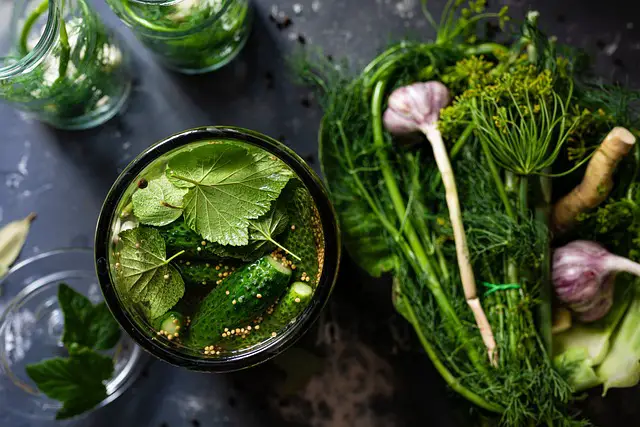Like any food with moisture, pickles too are susceptible to damage from mold especially give the fact that the method of preservation employs a liquid medium which makes for a perfect mold habitat.
Pickles can get mold when they are made from a brine solution that isn’t perfectly acidic, salted or preserved well during and after storage.
In the rest of the article, we’ll discuss more on what mold is, how it is able to thrive in a brine solution, what you can do to prevent its growth and hat you should do with pickles that have started growing mold on them.

What is a mold?
Mold is a fuzzy looking entity that grows on the surface of items (including food) and can have many different colors such as green, pink, yellow, orange, red, blue, white, brow, black or even a combination of colors.
It is a product of fungi that grows in mediums that are damp, have digestible energy source, have suitable temperature (55-70 F) and also have oxygen.
Mold growth can be identified on the surface of pickles as the fuzzy growth that looks like dust and is either white, black, blue, green or pinkish, and sometimes exude an offensive smell.
Is pickle brine a perfect medium for mold to grow?
As mentioned earlier, mold generally thrives in mediums that are damp, have an energy source, have a suitable temperature (which is between 55 to 70°F) and also have oxygen or a suitable air quality.
If you look closely, you can easily see how a pickle jar and all that it contains can serve as a breeding ground for mold.
The medium is certainly damp, has a digestible energy source in the form of the pickles or other ingredients in the brine, have a suitable temperature and also have the perfect air quality (oxygen).
Now, the question of where the mold itself comes from should definitely arise as mold certainly wont magically appear inside the container and begin to grow. It has to have come from somewhere and settled in the container.
So where does the mold that grown on our pickle juice come from?
The answer to that is simple.
Mold reproduce through spores that are scattered everywhere (in air) and are in continuous motion until they find a place to settle and breed or eventually get destroyed. This means that there is every likelihood that while preparing your glass jars for pickling, you must have has mold spores deposited into them, because they are inevitable. Other sources of mold could be the container itself or the vegetables used for the pickling.
These spores despite being in the jars however, cannot thrive and grow unless the medium there is suitable for them to grow. If that is the case, the spores would then have a chance to settle, grow, spread and eventually become visible to the eyes.
What causes mold to grow on pickle?
Even with the fulfillment of these 4 criteria mentioned above, mold still isn’t expected to grow inside a pickling jar, and the reason for that is the brine solution.
In case you didn’t know the chief cause of mold in a pickling jar is a poorly made brine. A brine solution is formulated with deliberate ratios of salt, water and vinegar in order to protect the pickles from harmful bacteria, as well as fungus growth.
If you deviate from the ratios specified by a tested recipe, then you are inherently create a medium that is suitable for mold to grow.
With the perfect brine solution, and also having followed the necessary steps of preparation carefully, no matter how much the medium fulfills the criteria, mold spores wont be able to growth because the brine medium would prevent them from doing so.
How to prevent pickle from growing mold
If you want to prevent mold growth on your pickle jar, then you have to make sure you’re sticking with the following practices below:
Follow a tested recipe
Pickle recipes exist for a reason, and that is to guide you on the perfect ratios to create a suitable medium for pickling. Following a recipe would ensure that you have a pickle that not only preserves for a very long time, but will be free from harmful microbes like bacteria and mold.
Under no circumstance should you ever change the ratio of salt to water in a brine recipe because the perfect amount of salt gives rise to the perfect acidity that helps kill harmful microbes and allow good microbes to thrive.
You should also never tamper with the amount of vinegar in a brine recipe because it acts the same way as salt — to balance acidity such that harmful microbes wont be able to grow.
If you follow a recipe and still somehow developed mold on your pickles, its likely that the recipe has ratios that aren’t in perfect proportions or you have introduced mold along the way during handling and storage.
Perfect submersion
Make sure the vegetables you’re pickling are perfectly submerged under the brine at all times as any exposed end would serve as a perfect medium for mold growth. To keep vegetables submerged under the brine, use a fermentation weight or wrap a sterilized stone in a layer of cabbage and place it directly on top of the brine.
Start with young, fresh produce
Starting with healthy produce means that you have less chance of running into a rotten pickle during fermentation and storage. Besides, aged or injured cucumbers may have already started to grow mold which can become pronounced during extended storage.
If fermenting using vinegar, ensure to keep the seal tight
Keeping the lid tight would ensure that air full of microbes isn’t introduced into the jar which can aid bacteria or mold growth. After opening the jar also, make sure to keep it in the refrigerator and not store on the counter as that would not only develop mold with time, but will harbor harmful microbes that can cause illness.
Use really clean jars
Clean the jars and seals properly to make sure there is no dust or even mold growing on them prior to stuffing your vegetables inside them.
Can you eat pickles with mold?
No, you should never consume pickles that have mold on them even after discarding the moldy parts. The reason is because some mold species can release harmful mycotoxins than cause problems when ingested, even though some species are totally harmless.
But remember, there is absolutely no way for you to determine at home what species of mold you have growing on the jar, how toxic that species of mold can be when ingested, and even what reactions you may develop after consuming the pickles. So it’s best to avoid guess work and protect your health by purposing the pickles into your compost.
Can pickles develop mold in the fridge?
Absolutely. Pickles can develop mold in the fridge when the species of mold that landed in your jar happens to be the ones that can thrive at refrigeration temperatures. The mold would be able to acquire nutrients from the brine, grown and begin to spread inside the jar.
Can pickles grow rotten?
Pickles can rot inside the brine medium whether they are kept outside or in the refrigerator, and this would mostly happen when you started off with a spoilt or old pickle to begin with or when the brine isn’t strong enough to kill the harmful microbes present in it which will thrive and cause the pickles to spoil early.
Pickles that have gone bad may turn slimy, look odd and even exude an offensive smell. Make sure to throw them out and not consume them.

